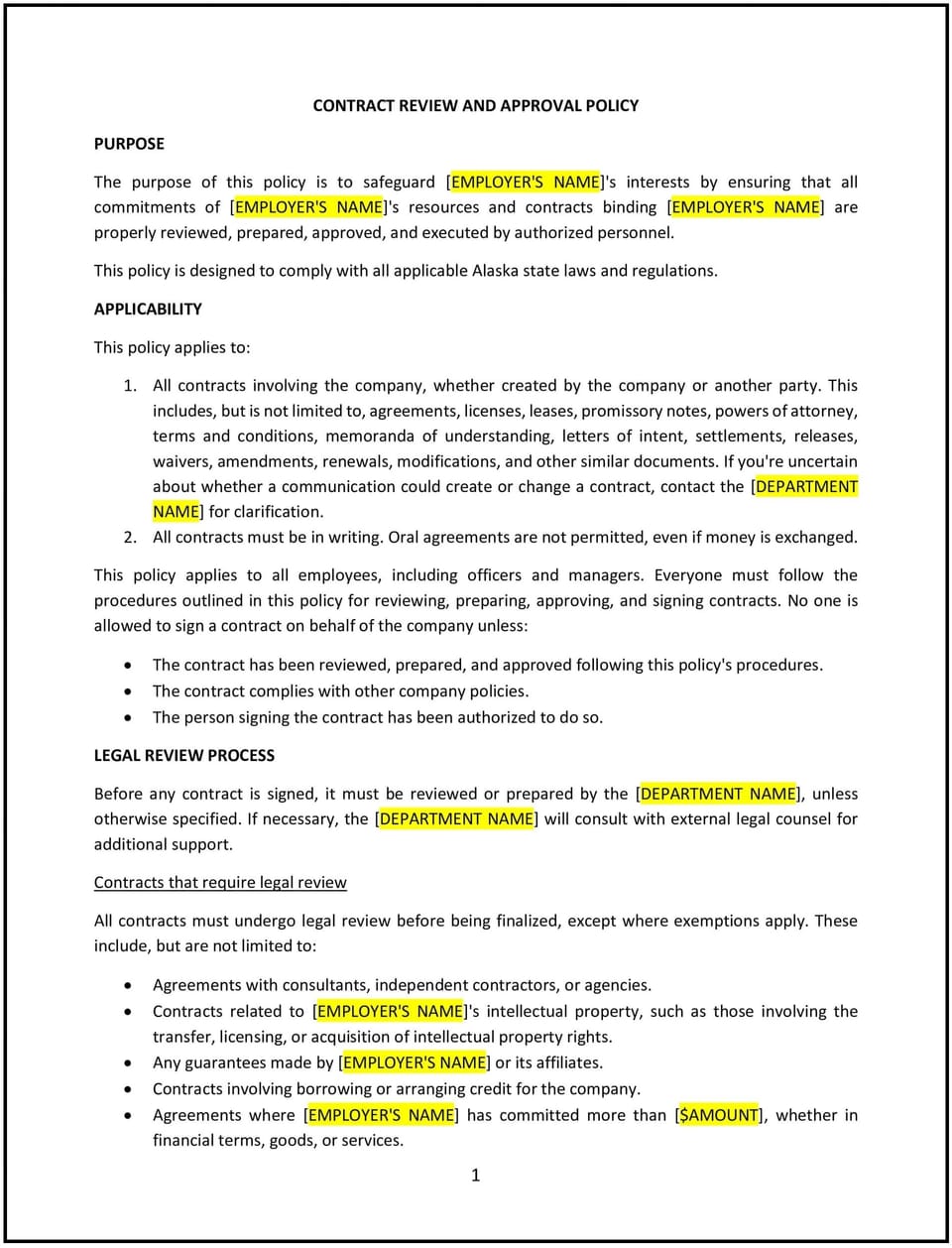Contract review and approval policy (Alaska): Free template

Contract review and approval policy (Alaska)
In Alaska, a contract review and approval policy establishes clear procedures for drafting, reviewing, and approving business agreements to minimize risks and ensure consistency. This policy helps businesses safeguard their interests by standardizing the process for evaluating contractual obligations and identifying potential risks before signing agreements. By implementing this policy, businesses can promote compliance, reduce errors, and enhance operational efficiency.
Given Alaska’s diverse industries and workforce, such as oil, gas, and tourism, this policy may include considerations for industry-specific requirements and unique operational challenges, such as remote communication or time-sensitive agreements.
How to use this contract review and approval policy (Alaska)
- Define the scope: Specify which types of contracts require review and approval under the policy, such as vendor agreements, client contracts, or employment agreements.
- Establish roles and responsibilities: Clearly assign roles for drafting, reviewing, and approving contracts, ensuring that each stage is handled by the appropriate personnel or departments.
- Outline review procedures: Provide guidelines for reviewing contracts, including key areas to evaluate, such as payment terms, liabilities, and termination clauses.
- Set approval thresholds: Define approval requirements based on the contract’s value, duration, or risk level, including when higher-level management or legal input is required.
- Ensure documentation: Require that all approved contracts are stored securely, with records of the review and approval process maintained for future reference.
Benefits of using a contract review and approval policy (Alaska)
A contract review and approval policy offers numerous benefits for businesses in Alaska. Here’s how it helps:
- Reduces risks: Identifies potential legal, financial, and operational risks before contracts are executed, protecting the company from unfavorable terms.
- Enhances compliance: Supports the business in meeting industry-specific standards and legal obligations through a consistent review process.
- Promotes accountability: Clearly defines roles and responsibilities, ensuring transparency and accountability throughout the contract lifecycle.
- Improves efficiency: Streamlines the contract review process, reducing delays and ensuring agreements are finalized in a timely manner.
- Maintains consistency: Standardizes the evaluation process, ensuring all contracts meet the company’s policies and objectives.
Tips for using a contract review and approval policy (Alaska)
- Use standard templates: Develop contract templates that reflect company-approved terms and reduce the need for extensive review of routine agreements.
- Include legal review: Require input from legal professionals for high-risk or high-value contracts to mitigate potential issues.
- Leverage technology: Consider using contract management software to track approvals, store records, and automate parts of the review process.
- Train employees: Provide training to ensure employees involved in drafting or approving contracts understand the policy and their responsibilities.
- Periodically review: Update the policy as needed to reflect changes in business operations, legal requirements, or industry best practices.
Q: What types of contracts should be covered under this policy?
A: The policy should apply to all agreements that create obligations for the business, including vendor contracts, client agreements, partnership agreements, and employment contracts.
Q: Who is responsible for reviewing contracts?
A: Responsibilities may vary based on the contract type or value, but typically involve department heads, legal counsel, and senior management for higher-risk agreements.
Q: How can businesses ensure contracts comply with this policy?
A: By using standard templates, implementing approval thresholds, and requiring documentation of the review and approval process, businesses can ensure compliance.
Q: What tools can help streamline the contract review process?
A: Contract management software can automate workflows, track approvals, and securely store contracts, improving efficiency and reducing manual errors.
Q: How often should the policy be updated?
A: The policy should be reviewed annually or whenever there are significant changes in business operations, legal requirements, or industry standards.
This article contains general legal information and does not contain legal advice. Cobrief is not a law firm or a substitute for an attorney or law firm. The law is complex and changes often. For legal advice, please ask a lawyer.


